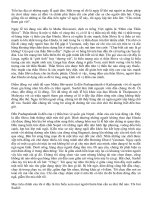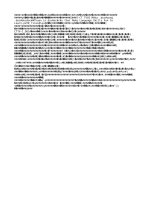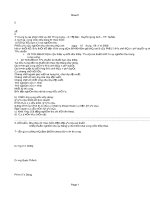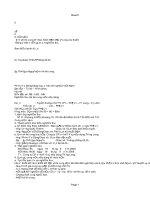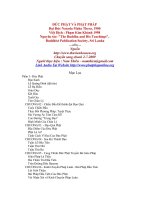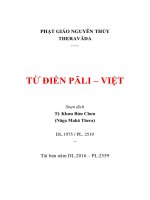maha satipatthona sutta
Bạn đang xem bản rút gọn của tài liệu. Xem và tải ngay bản đầy đủ của tài liệu tại đây (1.07 MB, 72 trang )
e
B
U
D
D
H
A
N
E
T
'
S
B
O
O
K
L
I
B
R
A
R
Y
E-mail:
Web site: www.buddhanet.net
Buddha Dharma Education Association Inc.
The Greater Discourse on Steadfast Mindfulness
Translated by
U Jotika and U Dhamminda
Maha Satipatthana Sutta
Maha Satipatthana Sutta
Mahàsatipaññhàna Sutta
The Greater Discourse on Steadfast Mindfulness
Translated by
U Jotika and U Dhamminda
2
To our preceptor
the late Venerable Taungpulu Kaba-Aye Sayadaw
of Burma
Sabba Dànaü Dhamma Dànaü Jinati
The Gift of Truth Excels All Other Gifts
Idaü te pu¤¤aü nibbànassa paccayo hotu
© U Jotika and U Dhamminda, Migadavun Monastery,
Ye Chan Oh Village, Maymyo, Burma. 1986.
All rights reserved. Permission to reprint or translate this
work may be freely obtained from the translators,
3
Introduction
Please practise in accordance with this Mahàsatipaññhàna
Sutta so that you can see why it is acknowledged as the
most important Sutta that the Buddha taught.
Try to practise all the different sections from time to time as
they are all useful, but in the beginning start with
something simple such as being mindful while walking (see
Iriyàpatha Pabba), or the mindfulness of in and out
breathing (see Anàpàna Pabba). Then as you practise these
you will be able to practise the other sections contained
within this Sutta and you will find that all the four
satipaññhànas can be practised concurrently.
A sutta should be read again and again as you will tend to
forget its message. The message here in this Sutta is that
you should be mindful of whatever is occurring in the body
and mind, whether it be good or bad, and thus you will
become aware that all conditioned phenomena are imper-
manent, unsatisfactory and not-self.
The original Pàëi text of this Sutta can be found in Mahà-
vagga of the Dãgha Nikàya.
4
Table of Contents
I. Kàyànupassanà (Contemplation on the Body)
i. ânàpàna Pabba (Section on In and Out Breathing)
ii. Iriyàpatha Pabba (Section on Postures)
iii. Sampaja¤¤a Pabba (Section on Clear Understanding)
iv. Pañikulamanasika Pabba
(Section on Contemplation of Impurities)
v. Dhàtumanasika Pabba
(Section on Contemplation of Elements)
vi. Navasivathika Pabba
(Section on Nine Stages of Corpses)
II. Vedanànupassanà (Contemplation on Feelings)
III. Cittànupassanà (Contemplation on the Mind)
5
6
IV. Dhammànupassanà (Contemplation on Dhammas)
i. Nãvara õa Pabba (Section on Hindrances)
ii. Khandha Pabba (Section on Aggregates)
iii. âyatana Pabba (Section on Sense Bases)
iv. Bojjhaïga Pabba (Section on Enlightenment Factors)
v. Sacca Pabba (Section on Noble Truths)
a. Dukkhasacca Pabba
(Section on the Noble Truth of Dukkha)
b. Samudayasacca Pabba
(Section on the Noble Truth of the Cause of Dukkha)
c. Nirodhasacca Pabba
(Section on the Noble Truth of the Cessation of Dukkha)
d. Maggasacca Pabba
(Section on the Noble Truth of the Path Leading to
the Cessation of Dukkha)
Notes
Mahàsatipaññhàna Sutta
Thus have I heard
1
. The Bhagavà
2
was at one time residing at
the market-town called Kammàsadhamma in the Kuru
country
3
. There the Bhagavà addressed the bhikkhus
4
say-
ing “O, Bhikkhus”, and they replied to him, “Bhadante,”
5
.
Then the Bhagavà said:
Bhikkhus, this is the one and the only way
6
for the puri-
fication (of the minds) of beings, for overcoming sorrow
and lamentation, for the cessation
7
of physical and mental
pain
8
, for attainment of the Noble Paths
9
. and for the realiz-
ation of Nibbàna
10
. That (only way) is the four satipaññhànas
11
.
What are these four?
12
Here (in this teaching), bhikkhus, a
bhikkhu (i.e. a disciple) dwells perceiving again and again
the body (kàya)
13
as just the body
14
(not mine, not I, not self,
but just a phenomenon) with diligence,
15
clear understand-
ing,
16
and mindfulness, thus keeping away covetousness
and mental pain in the world;
17
he dwells perceiving again
and again feelings (vedanà)
18
as just feelings (not mine, not I,
not self but just as phenomena) with diligence, clear under-
standing, and mindfulness, thus keeping away covetous-
ness and mental pain in the world; he dwells perceiving
again and again the mind (citta)
19
as just the mind (not mine,
not I, not self but just a phenomenon) with diligence, clear
understanding, and mindfulness, thus keeping away covet-
ousness and mental pain in the world; he dwells perceiving
again and again dhammas
20
as just dhammas (not mine, not I,
not self but just as phenomena) with diligence, clear under-
7
standing, and mindfulness, thus keeping away covetous-
ness and mental pain in the world.
I. Kàyànupassanà
i. ânàpàna Pabba
(Section on In and Out breathing)
And how, bhikkhus, does a bhikkhu dwell perceiving again
and again the body as just the body? Here (in this teaching),
bhikkhus, a bhikkhu having gone to the forest, or to the foot
of a tree, or to an empty, solitary place;
21
sits down cross-
legged,
22
keeping his body erect, and directs his mindful-
ness (towards the object of mindfulness).
23
Then only with
keen mindfulness he breathes in and only with keen mind-
fulness he breathes out. Breathing in a long breath, he
knows, “I breathe in a long breath”; breathing out a long
breath, he knows, “I breathe out a long breath”; breathing in
a short breath, he knows, “I breathe in a short breath”;
breathing out a short breath, he knows, “I breathe out a
short breath”, “Aware of the whole breath body, I shall
breathe in”,
24
thus he trains himself; “Aware of the whole
breath body, I shall breathe out”, thus he trains himself.
“Calming the process of breathing, I shall breathe in”,
25
thus
he trains himself; “Calming the process of breathing, I shall
breathe out”, thus he trains himself.
26
Just as, bhikkhus, a skilful turner or a turner’s apprentice
pulling a long pull (on the string turning the lathe), knows,
8
“I am pulling a long pull”; pulling a short pull, knows, “I am
pulling a short pull”, just so, bhikkhus, a bhikkhu breathing
in a long breath, knows, “I breathe in a long breath”; breath-
ing out a long breath, knows, “I breathe out a long breath”;
breathing in a short breath, knows, “I breathe in a short
breath”; breathing out a short breath, knows, “I breathe out
a short breath”. “Aware of the whole breath body, I shall
breathe in,” thus he trains himself; “Aware of the whole
breath body, I shall breathe out”, thus he trains himself.
“Calming the process of breathing, I shall breathe in”, thus
he trains himself; “Calming the process of breathing, I shall
breathe out”, thus he trains himself.
Thus he dwells perceiving again and again the body
27
as
just the body (not mine, not I, not self, but just a phenom-
enon) in himself; or he dwells perceiving again and again
the body as just the body in others;
28
or he dwells perceiving
again and again the body as just the body in both himself
and in others.
29
He dwells perceiving again and again the
cause and the actual appearing of the body; or he dwells per-
ceiving again and again the cause and the actual dissolution
of the body; or he dwells perceiving again and again both
the actual appearing and dissolution of the body with their
causes.
30
To summarize, he is firmly mindful of the fact that
only the body exists (not a soul, a self or I). That mindful-
ness is just for gaining insight (vipassanà) and mindfulness pro-
gressively. Being detached from craving and wrong views
3l
he dwells without clinging to anything in the world.
32
Thus,
bhikkhus, this is a way in which a bhikkhu dwells perceiv-
ing again and again the body as just the body.
9
ii. Iriyàpatha Pabba
(Section on Postures)
And again, bhikkus, a bhikkhu while walking
33
knows “I
am walking”;
34
while standing, he knows, “I am standing”;
while sitting, he knows, “I am sitting”; while lying down he
knows, “I am lying down.”
35
To summarize, a bhikkhu should know whatever way his
body is moving or placed.
36
Thus he dwells perceiving again and again the body
37
as
just the body (not mine, not I, not self, but just a phenom-
enon) in himself; or he dwells perceiving again and again
the body as just the body in others; or he dwells perceiving
again and again the body as just the body in both himself
and in others. He dwells perceiving again and again the
cause and the actual appearing of the body or he dwells
perceiving again and again the cause and the actual dis-
solution of the body; or he dwells perceiving again and
again the actual appearing and dissolution of the body with
their causes.
38
To summarize, he is firmly mindful of the fact
that only the body exists (not a soul, a self or I). That mind-
fulness is just for gaining insight (vipassanà) and mindful-
ness progressively. Being detached from craving and wrong
views he dwells without clinging to anything in the world.
Thus, bhikkhus, this is also a way in which a bhikkhu dwells
perceiving again and again the body as just the body.
10
iii. Sampaja¤¤a Pabba
(Section on Clear Understanding)
And again, bhikkhus, a bhikkhu, while going forward or
while going back does so with clear understanding;
39
while
looking straight ahead or while looking elsewhere he does
so with clear understanding; while bending or stretching his
limbs he does so with clear understanding; while carrying
the alms bowl and while wearing the robes he does so with
clear understanding; while eating, drinking, chewing, and
savouring he does so with clear understanding; while urin-
ating or defecating he does so with clear understanding;
while walking, standing, sitting, falling asleep, waking,
speaking or when remaining silent, he does so with clear
understanding.
Thus he dwells perceiving again and again the body, as just
the body in himself… Thus, bhikkhus, this is also a way in
which a bhikkhu dwells perceiving again and again the
body as just the body.
iv. Pañikulamanasika Pabba
(Section on Contemplation of Impurities)
And again, bhikkhus, a bhikkhu examines and reflects
closely upon this very body, from the soles of the feet up
and from the tips of the head hair down, enclosed by the
skin and full of various kinds of impurities,
40
(thinking thus)
“There exists in this body: hair of the head, hair of the body,
nails, teeth, skin, flesh, sinews, bones, marrow, kidneys,
11
heart, liver, membranes (including the pleura, the dia-
phragm and other forms of membrane in the body), spleen,
lungs, intestines, mysentery, gorge, fæces, brain, bile,
phlegm, pus, blood, sweat, solid fat, tears, liquid fat, saliva,
mucus, synovic fluid (i.e. lubricating oil of the joints) and
urine.”
Just as if, bhikkhus, there were a double-mouthed provision
bag filled with various kinds of grain such as: hill-paddy,
paddy, green-gram, cow pea, sesamum, and husked rice;
and a man with sound eyes, having opened it, should ex-
amine it thus: “This is hill-paddy, this is paddy, this is
green-gram, this is cow pea, this is sesamum, and this is
husked rice.” Just so, bhikkhus, a bhikkhu examines and
reflects closely upon this very body, from the soles of the
feet up and from the tips of the head hair down, enclosed
by the skin and full of various kinds of impurities, (thinking
thus) “There exists in this body: hair of the head, … and
urine.’’
Thus he dwells perceiving again and again the body as just
the body in himself…. Thus, bhikkhus, this is also a way in
which a bhikkhu dwells perceiving again and again the
body as just the body.
v. Dhàtumanasika Pabba
(Section on Contemplation on Elements)
And again, bhikkhus, a bhikkhu examines and reflects
closely upon this very body however it be placed or dis-
12
posed as composed of (only) primary elements
4l
thus:
“There exists in this body the earth element, the water
element, the fire element, and the air element.”
42
Just as if, bhikkhus, a skillful butcher or his apprentice, hav-
ing slaughtered a cow and divided it into portions were
sitting at the junction of four high roads,
43
just so, a bhikkhu
examines and reflects closely upon this body however it be
placed or disposed as composed of (only) the primary elem-
ents thus: “There exists in this body the earth element, the
water element, the fire element and the air element.’’
Thus he dwells perceiving again and again the body as just
the body in himself…. Thus bhikkhus, this is also a way in
which a bhikkhu dwells perceiving again and again the
body as just the body.
vi. Navasivathika Pabba
(Section on Nine Stages of Corpses)
Part 1
And again, bhikkhus, if a bhikkhu should see a body, one
day dead, or two days dead, or three days dead, swollen,
blue and festering, discarded in the charnel ground, he then
compares it to his own body thus: “Truly this body is of the
same nature, it will become like that and cannot escape
from it.”
44
Thus he dwells perceiving again and again the body as just
the body in himself…. Thus, bhikkhus, this is also a way in
13
which a bhikkhu dwells perceiving again and again the
body as just the body.
Part 2
And again, bhikkus, if a bhikkhu should see a body dis-
carded in the charnel ground, being devoured by crows,
being devoured by hawks, being devoured by vultures,
being devoured by herons, being devoured by dogs, being
devoured by tigers, being devoured by leopards, being
devoured by jackals, or being devoured by various kinds of
worms, he then compares it to his own body thus: ‘‘Truly
this body is of the same nature, it will become like that and
cannot escape from it.’’
Thus he dwells perceiving again and again the body as just
the body in himself…. Thus, bhikkhus, this is also a way in
which a bhikkhu dwells perceiving again and again the
body as just the body.
Part 3
And again, bhikkhus, if a bhikkhu should see a body dis-
carded in the charnel ground, that is just a skeleton held
together by the tendons, with some flesh and blood still
adhering to it, he then compares it to his own body thus:
“Truly this body is of the same nature, it will become like
that and cannot escape from it.”
Thus he dwells perceiving again and again the body as just
the body in himself…. Thus, bhikkhus, this is also a way in
14
which a bhikkhu dwells perceiving again and again the
body as just the body.
Part 4
And again, bhikkhus, if a bhikkhu should see a body, dis-
carded in the charnel ground, that is just a skeleton held
together by the tendons, blood-besmeared, fleshless, he then
compares it to his own body thus: “Truly this body is of the
same nature, it will become like that and cannot escape
from it.”
Thus he dwells perceiving again and again the body as just
the body in himself…. Thus, bhikkhus, this is also a way in
which a bhikkhu dwells perceiving again and again the
body as just the body.
Part 5
And again, bhikkhus, if a bhikkhu should see a body, dis-
carded in the charnel ground, that is just a skeleton held
together by the tendons without flesh and blood, he then
compares it to his own body thus: “Truly this body is of the
same nature, it will become like that and cannot escape
from it.”
Thus he dwells perceiving again and again the body as just
the body in himself…. Thus, bhikkhus, this is also a way in
which a bhikkhu dwells perceiving again and again the
body as just the body.
15
Part 6
And again, bhikkhus, if a bhikkhu should see a body, dis-
carded in the charnel ground, that is just loose bones
scattered in all directions; at one place bones of a hand, at
another place bones of a foot, at another place ankle-bones,
at another place shin-bones, at another place thigh-bones, at
another place hip-bones, at another place rib-bones, at an-
other place spinal-bones, at another place shoulder-bones,
at another place neck-bones, at another place the jawbone,
at another place the teeth, and at another place the skull, he
then compares it to his own body thus: “Truly this body is
of the same nature, it will become like that and cannot
escape from it.”
Thus he dwells perceiving again and again the body as just
the body in himself…. Thus, bhikkhus, this is also a way in
which a bhikkhu dwells perceiving again and again the
body as just the body.
Part 7
And again, bhikkhus, if a bhikkhu should see a body, dis-
carded in the charnel ground, that is just white bones of
conch-like colour, he then compares it to his own body thus:
“Truly this body is of the same nature, it will become like
that and cannot escape from it.”
Thus he dwells perceiving again and again the body as just
the body in himself…. Thus, bhikkhus, this is a way in
16
which a bhikkhu dwells perceiving again and again the
body as just the body.
Part 8
And again, bhikkhus, if a bhikkhu should see a body, dis-
carded in the charnel ground, that is bones more than a year
old, lying in a heap, he then compares it to his own body
thus: “Truly this body is of the same nature, it will become
like that and cannot escape from it.”
Thus he dwells perceiving again and again the body as just
the body in himself…. Thus, bhikkhus, this is also a way in
which a bhikkhu dwells perceiving again and again the
body as just the body.
Part 9
And again, bhikkhus, if a bhikkhu should see a body, dis-
carded in the charnel ground, that is just rotted bones,
crumbling to dust, he then compares it to his own body
thus: “Truly this body is of the same nature, it will become
like that and cannot escape from it.”
Thus he dwells perceiving again and again the body as just
the body (not mine, not I, not self, but just a phenomenon)
in himself; or he dwells perceiving again and again the
body as just the body in others; or he dwells perceiving
again and again the body as just the body in both himself
and in others. He dwells perceiving again and again the
cause and the actual appearing of the body or he dwells
17
perceiving again and again the cause and the actual
dissolution of the body; or he dwells perceiving again and
again both the actual appearing and dissolution of the body
with their causes. To summarize, he is firmly mindful of the
fact that only the body exists (not a soul, a self or I). That
mindfulness is just for gaining insight (vipassanà) and
mindfulness progressively. Being detached from craving
and wrong views he dwells without clinging to anything in
the world. Thus, bhikkhus, this is also a way in which a
bhikkhu dwells perceiving again and again the body as just
the body.
II. Vedanànupassanà
And how, bhikkhus, does a bhikkhu dwell perceiving again
and again that feelings (vedanà)
45
are just feelings (not mine,
not I, not self but just as phenomena)?
Here (in this teaching), bhikkhus, while experiencing a pleas-
ant feeling,
46
a bhikkhu knows, “I am experiencing a pleas-
ant feeling”; or while experiencing an unpleasant feeling,
47
he knows, “I am experiencing an unpleasant feeling”; or
while experiencing a feeling that is neither pleasant nor un-
pleasant,
48
he knows, “I am experiencing a feeling that is
neither pleasant nor unpleasant.’’
While experiencing a pleasant feeling associated with sense
pleasures,
49
he knows, “I am experiencing a pleasant feeling
associated with sense pleasures”; or while experiencing a
18
pleasant feeling not associated with sense pleasures,
50
he
knows, “I am experiencing a pleasant feeling not associated
with sense pleasures.’’
While experiencing an unpleasant feeling associated with
sense pleasures,
51
he knows, “I am experiencing an unpleas-
ant feeling associated with sense pleasures”; or while
experiencing an unpleasant feeling not associated with
sense pleasures,
52
he knows, ‘‘I am experiencing an un-
pleasant feeling not associated with sense pleasures.’’
While experiencing a feeling, that is neither pleasant nor
unpleasant that is associated with sense pleasures,
53
he
knows, “I am experiencing a feeling that is neither pleasant
nor unpleasant that is associated with sense pleasures”; or
while experiencing a feeling that is neither pleasant nor
unpleasant that is not associated with sense pleasures, he
knows, “I am experiencing a feeling that is neither pleasant
nor unpleasant that is not associated with sense pleasures.’’
Thus he dwells perceiving again and again feelings as just
feelings (not mine, not I, not self, but just as phenomena) in
himself; or he dwells perceiving again and again feelings as
just feelings in others; or he dwells perceiving again and
again feelings as just feelings in both himself and in others.
He dwells perceiving again and again the cause and the
actual appearing of feelings; or he dwells perceiving again
and again the cause and the actual dissolution of feelings; or
he dwells perceiving again and again both the actual
appearing and dissolution of feelings with their causes.
54
To
19
summarize, he is firmly mindful of the fact that only feel-
ings exists (not a soul, a self or I). That mindfulness is just
for gaining insight (vipassanà) and mindfulness pro-
gressively. Being detached from craving and wrong views
he dwells without clinging to anything in the world. Thus,
bhikkhus, in this way a bhikkhu dwells perceiving again
and again feelings as just feelings.
III. Cittànupassanà
And how, bhikkhus, does a bhikkhu dwell perceiving again
and again the mind (citta) as just the mind (not mine, not I,
not self but just a phenomenon)?
Here (in this teaching), bhikkhus, when a mind with greed
(ràga)
55
arises, a bhikkhu knows, “This is a mind with
greed”; or when a mind without greed
56
arises, he knows,
“This is a mind without greed”; when a mind with anger
(dosa)
57
” arises, he knows, “This is a mind with anger”; or
when a mind without anger
58
arises, he knows, “This is a
mind without anger”; when a mind with delusion (moha)
59
arises, he knows, “This is a mind with delusion”; or when a
mind without delusion
60
arises, he knows, “This is a mind
without delusion”; or when a lazy, slothful mind (saükhitta-
citta)
61
arises, he knows, “This is a lazy, slothful mind”; or
when a distracted mind (vikkhittacitta)
62
arises, he knows,
“This is a distracted mind”; or when a developed mind
(mahagattacitta)
63
arises, he knows, “This is a developed
mind”; or when an undeveloped mind (amahagattacitta)
64
arises, he knows, “This is an undeveloped mind”; or when
20
an inferior mind (sauttaracitta)
65
arises, he knows, “This is an
inferior mind”; or when a superior mind (anuttaracitta)
66
arises, he knows, “This is a superior mind”; or when a
concentrated mind (samàhitacitta)
67
arises, he knows, “This is
a concentrated mind”; or when an unconcentrated mind
(asamàhitacitta)
68
arises, he knows, “This is an unconcen-
trated mind’’; or when a mind temporarily free from
defilements (vimutticitta)
69
arises, he knows, “This is a mind
temporarily free from defilements”; or when a mind not
free from defilements (avimutticitta) arises, he knows, “This
is a mind not free from defilements”.
Thus he dwells perceiving again and again the mind as just
the mind (not mine, not I, not self but just a phenomenon)
in himself; or he dwells perceiving again and again the
mind as just the mind in others; or he dwells perceiving
again and again the mind as just the mind in both himself
and in others. He dwells perceiving again and again the
cause and the actual appearing of the mind; or he dwells
perceiving again and again the cause and the actual
dissolution of the mind; or he dwells perceiving again and
again both the actual appearing and dissolution of the mind
with their causes.
70
To summarize, he is firmly mindful of
the fact that only the mind exists (not a soul, self or I). That
mindfulness is just for gaining insight (vipassanà) and mind-
fulness progressively. Being detached from craving and
wrong views he dwells without clinging to anything in the
world. Thus, bhikkhus, in this way a bhikkhu dwells per-
ceiving again and again the mind as just the mind.
21
IV. Dhammànupassanà
i. Nãvaraõa Pabba
(Section on Hindrances)
And how, bhikkhus, does a bhikkhu dwell perceiving again
and again dhammas as just dhammas (not mine, not I, not
self, but just as phenomena)? Here (in this teaching),
bhikkhus, a bhikkhu dwells perceiving again and again the
five hindrances (nãvaraõa dhamma) as just the five hin-
drances
7l
(not mine, not I, not self, but just as phenomena).
And how, bhikkhus, does a bhikkhu dwell perceiving again
and again the five hindrances as just the five hindrances?
Here (in this teaching), bhikkhus, while sense-desire
(kàmachanda) is present in him, a bhikkhu knows, “There is
sense-desire present in me”; or while sense-desire is not
present in him, he knows, “There is no sense-desire present
in me”. He also knows how the sense-desire which has not
yet arisen comes to arise; he knows how the sense-desire
that has arisen comes to be discarded; and he knows how
the discarded sense-desire will not arise in the future.
72
While ill-will (byàpàda) is present in him he knows, “There is
ill-will present in me”; or while ill-will is not present in him,
he knows, “There is no ill-will present in me.” He also
knows how the ill-will which has not yet arisen comes to
arise; he knows how the ill-will which has arisen comes to
be discarded; and he knows how the discarded ill-will will
not arise in the future.
73
22
While sloth and torpor are present in him, he knows, “There
are sloth and torpor present in me”; or while sloth and
torpor are not present in him, he knows “There is no sloth
and torpor present in me.” He also knows how the sloth
and torpor which has not yet arisen comes to arise; he
knows how the sloth and torpor that has arisen comes to be
discarded; and he knows how the discarded sloth and
torpor will not arise in the future.
74
While distraction and worry (uddhacca-kukkucca) are present
in him, he knows, “There are distraction and worry present
in me”; or while distraction and worry are not present in
him, he knows, “There are no distraction and worry present
in me.” He knows how the distraction and worry which has
not yet arisen comes to arise, he knows how the distraction
and worry that has arisen comes to be discarded; and he
knows how the discarded distraction and worry will not
arise in the future.
75
While doubt or wavering of the mind (vicikicchà) is present
in him, he knows, “There is doubt or wavering of the mind
present in me”; or while doubt or wavering of the mind is
not present in him, he knows, “There is no doubt or waver-
ing of mind present in me.” He also knows how the doubt
or wavering of mind which has not yet arisen comes to
arise; he knows how the doubt or wavering of mind that
has arisen comes to be discarded; and he knows how the
discarded doubt or wavering of mind will not arise in the
future.
76
23
Thus he dwells perceiving again and again dhammas as just
dhammas (not mine, not I, not self, but just as phenomena)
in himself; or he dwells perceiving again and again dhammas
as just dhammas in others; or he dwells perceiving again
and again dhammas as just dhammas in both himself and in
others. He dwells perceiving again and again the cause and
the actual appearing of dhammas; or he dwells perceiving
again and again the cause and the actual dissolution of
dhammas; or he dwells perceiving again and again both the
actual appearing and dissolution of dhammas with their
causes.
77
To summarize, he is firmly mindful of the fact that
only dhammas exist (not a soul, a self or I). That mindful-
ness is just for gaining insight (vipassanà) and mindfulness
progressively. Being detached from craving and wrong
views he dwells without clinging to anything in the world.
Thus, bhikkhus, in this way a bhikkhu dwells perceiving
again and again the five hindrances as just the five hin-
drances.
ii. Khanda Pabba
(Section on Aggregates)
And again, bhikkhus, a bhikkhu dwells perceiving again
and again the five aggregates of clinging (upàdàna-
kkhandha)
78
as just the five aggregates of clinging (not mine,
not I, not self but just as phenomena).
And how, bhikkhus, does a bhikkhu dwell perceiving again
and again the five aggregates of clinging as just the five
aggregates of clinging?
24
Here (in this teaching), bhikkhus, a bhikkhu perceives thus:
“This is the corporeal body (råpa); this is the cause and the
actual appearing of the corporeal body; this is the cause and
the actual dissolution of the corporeal body. This is feeling
(vedanà) this is the cause and the actual appearing of feeling;
this is the cause and the actual dissolution of feeling. This is
perception (sa¤¤à); this is the cause and the actual
appearing of perception; this is the cause and the actual
dissolution of perception. These are mental formations
(saïkhàra); this is the cause and the actual appearing of
mental formations; this is the cause and the actual
dissolution of mental formations. This is consciousness
(vi¤¤àõa); this is the cause and the actual appearing of
consciousness; this is the cause and the actual dissolution of
consciousness.”
79
Thus he dwells perceiving again and again dhammas as just
dhammas (not mine, not I, not self, but just as phenomena)
in himself; or he dwells perceiving again and again dhammas
as just dhammas in others; or he dwells perceiving again
and again dhammas as just dhammas in both himself and
others. He dwells perceiving again and again the cause and
the actual appearing of dhammas; or he dwells perceiving
again and again the cause and the actual dissolution of
dhammas; or he dwells perceiving again and again both the
actual appearing and dissolution of dhammas with their
causes.
80
To summarize, he is firmly mindful of the fact that
only dhammas exist (not a soul, a self or I). That mindful-
ness is just for gaining insight (vipassanà) and mindfulness
25
